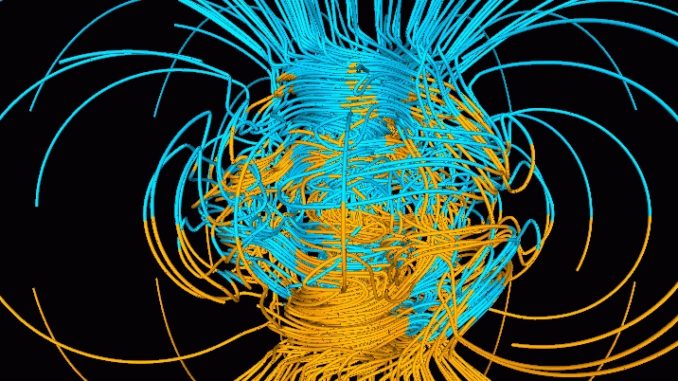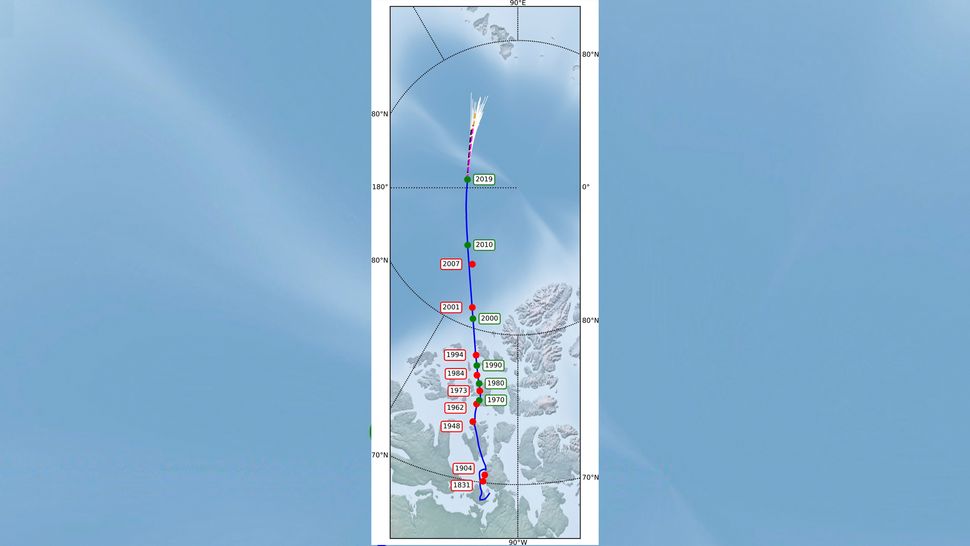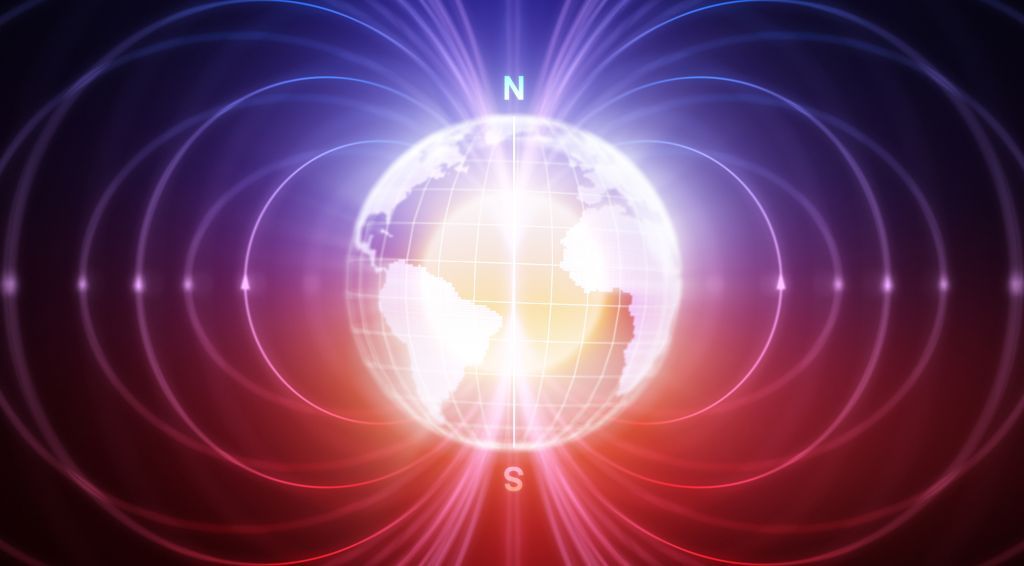
Earth’s magnetic poles have never been content to sit motionless in the same spot. They’ve always been on the move, and always will be. The North and South magnetic poles move independently of one another – the South magnetic pole has not seen the same rapid movement in the last quarter century that the North magnetic pole has. This recent rapid movement of the North magnetic pole has brought international attention to the phenomenon, generating questions and concerns from the public worldwide.
Magnetic compasses have been in use for nearly a millenium. However, the position of Earth’s North magnetic pole was only first located in 1831, in far north Canada. Location records of the wandering pole have been kept since, indicating mostly slow movement. However, in the last thirty years, the magnetic North pole has moved very rapidly, much faster than average, from Canadian territory towards Siberia. Scientists now have a theory why this is happening, which we’ll discuss a little later on. First, we need to provide some background context and understanding.

Note that the magnetic North and South poles are seperate and distinct from the physical North and South poles. The physical poles are fixed in place on the Earth’s surface and never move: they can be thought of as two ends of an imaginary line running through the center of the rotating Earth called the axis. If the Earth was a bicycle wheel, the axis would be the axle in the center of the bike wheel’s hub.
If the magnetic poles are not the same as the physical poles, what are they? Let’s describe what they look like and then later we’ll discuss the “machinery” that causes them.
You may remember playing with a bar magnet as a kid and learning about it in school. The bar magnet has two poles, north and south (thus referred to as a ‘dipole’ magnet). The classic science class demonstration of a bar magnet involves laying a sheet of paper over the magnet and sprinkling iron filings on top. The filings neatly arrange themselves on the magnetic field lines surrounding the magnet.

The Earth’s magnetic field looks very much like the magnetic field of a bar magnet. It’s almost as if there’s a ginormous bar magnet inside the Earth, running from the Arctic to the Antarctic. Alas, there is not and the explanation is slightly more complex than that. Fear not though, the Owl is ready with an easy to comprehend elucidation.

A humongous bar magnet isn’t the only way to create a magnetic field around the Earth. Electricity can also create a magnetic field. In fact, electricity and magnetism are intertwined. Electricity moving through a wire (electric current) always creates a magnetic field surrounding the wire. Conversely, if you have a magnet, you can make electricity: move a bar magnet through a few loops of wire and you’ll generate an electric current in the wire. Electricity and magnetism are so inseparable, scientists talk about them as electromagnetism and electromagnetic fields.
Whoa… Wait… What? Is the Owl suggesting that electricity is flowing inside the Earth and generating an enormous spherical magnetic field around our planet? Yes! That is exactly what’s happening.
How is this possible? By studying shockwaves caused by earthquakes, and by several other means, scientist have a picture of what the interior of our planet looks like. There’s the dense solid inner core, liquid outer core, mantel, asthenosphere, lithosphere, and crust.

According to current scientific thinking known as the dynamo theory, there’s a bunch of stuff going on in the molten liquid outer core deep below our feet. It’s rotating just like the rest of the planet, and there’s a lot of convection going on as well, with hotter material rising and cooler material sinking. The kicker is that all this molten fluid is a great conductor of electricity, with copious amounts of free electrons. (Recall that heat energy excites electrons enough to break free of the bonds they normally have with atoms). So, we have a great deal of molten material rotating around an axis, and moving up and down, carrying free electrons along with it. This all adds up to an astronomically large amount of electrical current, which we now know has an associated intertwined magnetic field bigger than planet Earth.
Now we can finally talk about the new theory that scientists have proposed to explain why the North magnetic pole is moving. They observed that prior to 1990, satellite data indicated that there were two lobes of magnetic flux (magnetic field lines) in the Arctic that were more intense than other areas in the region. One of the blobs is under Canada, the other blob is under Siberia. They theorize that these intense field lines eminate from “blobs” in the outer core that have a greater flow of molten material than other outer core regions underneath the Arctic cap. As a result, there’s greater electrical current activity in these blobs which also means greater magnetic field strength.
As long as the strength of the fields in the two lobes remained roughly equal, the magnetic North pole didn’t move much. That began to change in the nineties, as the Canadian blob began to elongate resulting in a weakening of field line intensity. The trend accelerated from 1999 onward, with the Canadian blob becoming weaker and the Siberian blob becoming stronger. The magnetic North pole left Canada and in 2017 dashed past the physical North pole, with no indication of slowing anytime soon.
One of the greatest concerns the public has had as a result of the sudden change in the magnetic North pole is the possibility of pole reversal. That’s when the magnetic North becomes magnetic South and vice-a-versa. Pole reversal has occurred many times in the planet’s past and no doubt will happen many times in the future. When the reversal occurs, it takes place slowly over hundreds or thousands of years. The reversal caused no harm to life in the past, and won’t in the future, so rest easy!
Question of the night: Magnets attract iron. What do you attract?
